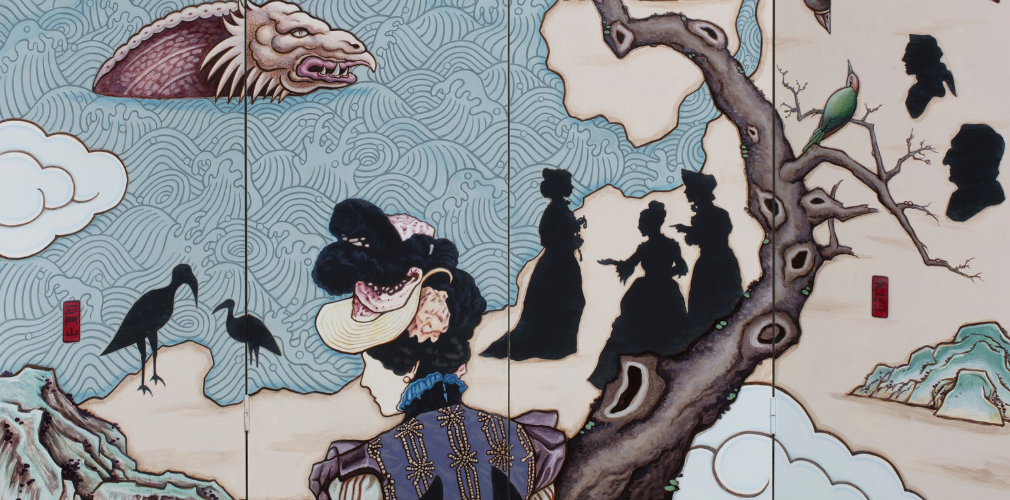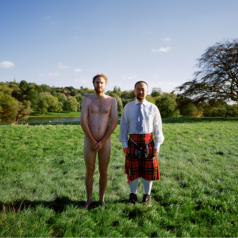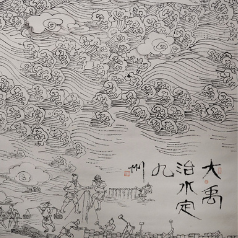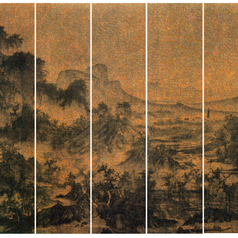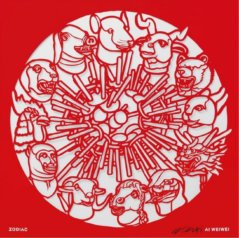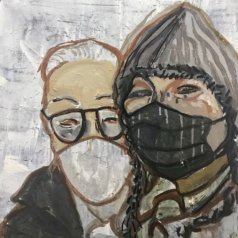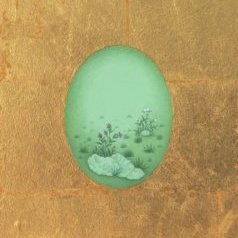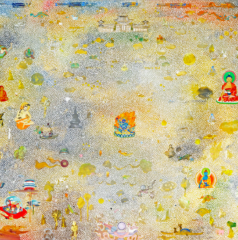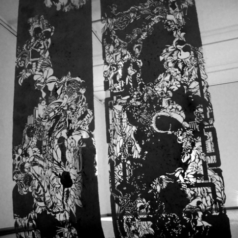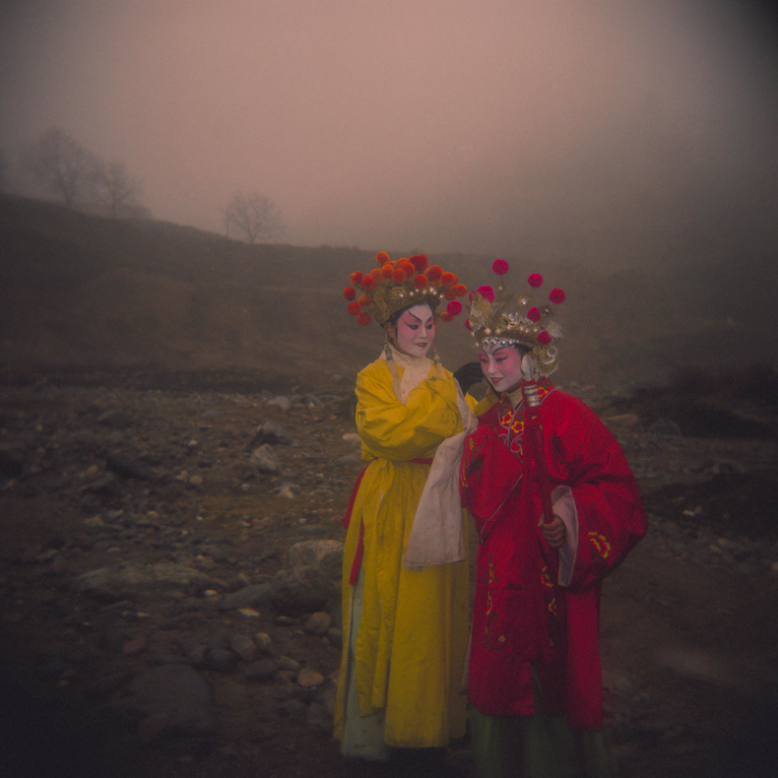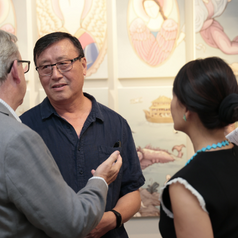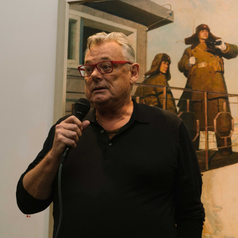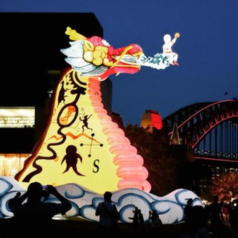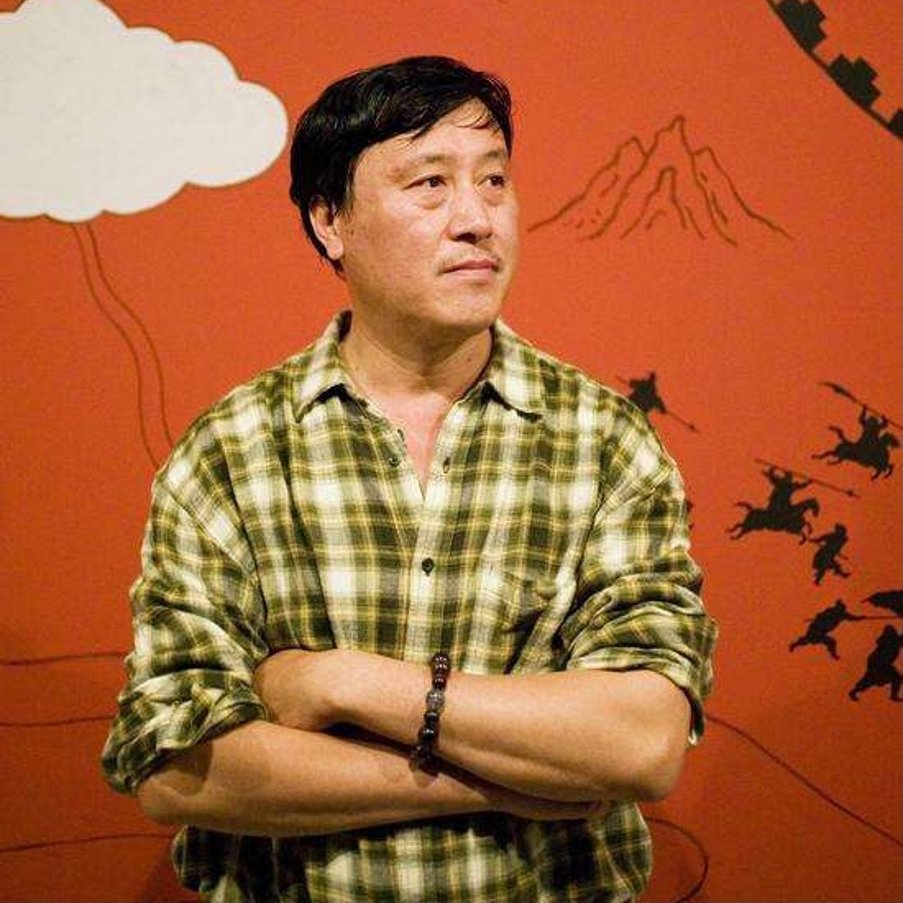
Guan Wei (b.1957, Beijing, China) has a significant international reputation as a contemporary artist whose work crosses cultural and political borders, specifically between Australia and Asia. A Chinese national who migrated to Australia in 1989, his practice which spans more than 30 years draws on his personal experience of both Chinese and Australian culture, as well as an informed socio-political awareness and knowledge of art history.
Guan Wei has held more than 70 solo exhibitions internationally. He also has been included in important international exhibitions, including Shanghai Biennial, China (2010); 10th Havana Biennial, Cuba (2009); Osaka Triennial, Japan (2001); Gwangju Biennale, South Korea (2000); Third Asia-Pacific Triennial of Contemporary Art, Australia (1999), etc. In 2019, the Museum of Contemporary Art Australia (MCA) held Guan Wei MCA Collection show dedicated to the museum’s collection of Guan Wei’s work over 30 years.
Video
CV
| 1957 | Born in Beijing, China |
| 1986 | Graduated from the Department of Fine Arts, Beijing Capital University |
| Present | Lives and works in Beijing and Sydney |
| 2021 | “Guan Wei: A Digital Age”, ARC ONE Gallery, Melbourne, Australia |
| 2020 | “Guan Wei: A Case Study”, Museum of Art & Culture Lake Macquarie, NSW, Australia |
| 2019 | “Essence, Energy, Spirit”, Australia-China Institute for Arts and Culture, Sydney, Australia |
|
“Guan Wei: Museum of Contemporary Art Australia Collection”, Museum of Contemporary Art Australia, Sydney, Australia
|
|
| 2018 | “Chivalry”, ARC ONE Gallery, Melbourne, Australia |
| “Unexpected Histories”, The University of Chicago Center in Beijing, China | |
| 2017 | “Cosmotheoria”, White Box Art Center 798 Art District Beijing, China |
| “Reflection”, Martin Browne Contemporary Sydney, Sydney, Australia | |
| 2016 | “Guan. Perspective”, Scene Sense Art Gallery, Beijing, China |
| “Bird, Map, Shadow”, Heiser Gallery QLD , Queensland, Australia | |
| “Salvation”, ARC ONE Gallery, Melbourne, Australia | |
| “Off – See. An Ephemeral Coincidence of Past and Present Impression the Eminence”, Wah | |
| Shun White Netherlands Academy of Arts, Beijing, China | |
| 2015 | “Panorama, Art of Guan Wei”, Jia Pingwa Cultural Museum of Art Xi’an, Xi’an, China |
| “From Stars To Soul”, Martin Browne Contemporary, Sydney, Australia | |
| “The Great Southern World”, Nancy Sever Gallery, Canberra, Australia | |
| “Guan Wei & Wayne Warren Crossing Lines”, ACME Project Space, London, UK | |
| 2014 | “Archaeology”, ARC ONE Gallery, Melbourne, Australia |
| “How Far”, Heiser Gallery Brisbane, Australia | |
| “From the water to the sky”, Glasshouse Port Macquarie Regional Gallery, NSW, Australia | |
| 2013 | “Twinkling Galaxies”, Martin Browne Contemporary, Sydney, Australia |
| “Enigma Space”, Moonlight 8 Gallery, Suzhou, China | |
| 2012 | “The Enchantment”, ARC ONE Gallery, Melbourne, Australia |
| 2011 | “The New Classic of the Mountains and Seas by Guan Wei”, Red Gate Gallery, Beijing, China |
| “Spellbound – Guan Wei 2011”, OCAT Museum, Shenzhen, China | |
| 2010 | “Cloud in the Sky and Water in the Bottle”, Shuimu Art Space, Beijing |
| “Cloud”, ARC One Gallery, Melbourne, Australia | |
| 2009 | “Fragments of History”, Kaliman Gallery, Sydney, Australia |
| “Longevity for Beginners”, 10 Chancery Lane Gallery, Hong Kong SAR, China | |
| 2008 | “Great Journey”, Yonghe Museum, Beijing, China |
| 2007 | “A Mysterious Land”, ARC One Gallery, Melbourne, Australia |
| “Day After Tomorrow”, Red Gate Gallery, Beijing, China | |
| 2006 | “A Mysterious Land”, ARC One Gallery, Melbourne, Australia |
| “Guan Wei”, Red Gate Gallery, Beijing, Australia | |
| “Other Histories”, Powerhouse Museum, Sydney, Australia | |
| 2005 | “Secret Histories”, Arc One Gallery, Melbourne, Australia |
| 2004 | “Looking for Enemies”, Sherman Galleries, Sydney, Australia |
| 2002 | “Island”, Sherman Galleries, Sydney, Australia |
| 2000 | “Horoscope”, Red Gate Gallery, Beijing, Australia |
| 1999 | “Floating”, Sherman Galleries, Sydney, Australia |
| “Nesting, or the Art of Idleness 1989 – 99”, Museum of Contemporary Art Australia, Sydney | |
| 1998 | “Internal Circulation”, Red Gate Gallery, Beijing, China |
| 1997 | “The Last Supper”, Tokyo Gallery, Japan |
| “Ex / Inspire”, Sherman Galleries, Sydney, Australia | |
| 1996 | “Returns to Paradise”, Red Gate Gallery, Beijing, China |
| “Magic Garden”, Hanart TZ Gallery, Hong Kong SAR, China |
| 2021 | “Precious Treasures”, Incinerator Art Space, Willoughby City Council, NSW, Australia |
| 2020 | “Pulse of the Dragon”, Casula Powerhouse Art Centre, NSW, Australia |
| “Between Two Worlds”, Newcastle Art Gallery, NSW, Australia | |
| “In one drop of water”, Art Gallery of NSW, Sydney, Australia | |
| “Between the Moon and the Stars”, Museum And Art Gallery Northern Territory, Australia | |
| 2018 | “Infinite Conversations: Asian-Australian artistic exchange”, National Gallery of Australia, |
| Canberra, Australia | |
| “2018 On Paper. Supreme.”, 541 Art Space, Sydney, Australia | |
| “The Exhibition of Annual of Contemporary Art of China”, Beijing Minsheng Art Museum, | |
| Beijing, China | |
| 2017 | “The Archibald, Wynne and Sulman Prizes exhibition”, Art Gallery of NSW, Sydney, Australia |
| “Collective Vision 130 Years”, Bendigo Art Gallery, Victoria, Australia | |
| “Charming Confusion”, Vermilion Art, Sydney, Australia | |
| 2016 | “Borders, Barriers, Walls”, Monash University Museum of Art, Melbourne, Australia |
| “2016 Archibald Prize”, Art Gallery of NSW, Sydney, Australia | |
| “Foreshadow”, Vermilion Art, Sydney, Australia | |
| “Review & Prospect”, NSW Parliament House, Sydney, Australia | |
| 2015 | “ANZAC commemoration exhibition”, The Casula Powerhouse Art Centre, Sydney, Australia |
| “Clouds Intersected”, China Cultural Centre, Sydney, Australia | |
| “Beijing Calling”, Vermilion Art Gallery, Sydney, Australia | |
| “Recombination and Mutation of Gene”, The 1st International Biennial of Contemporary | |
| 2014 | “Melbourne Art Fair”, ARC ONE Gallery, Royal Exhibition Building. |
| “Myh /History”, Yuz collection of Contemporary Art Shanghai | |
| “Conflict Contemporary Responses to War”, The University of Queensland Art Museum, Brisbane, Australia | |
| 2013 | “Snake, Snake, Snake”, Sydney Town Hall, Australia |
| “MCA Collection exhibition Volume one part two”, Museum of Contemporary Art Australia, Sydney, Australia | |
| 2012 | “Negotiating This World Contemporary Australian Art”, National Gallery of Victoria, Melbourne, Australia |
|
“Contemporary Australian Drawing 2: Drawing as Notation, text and discovery”, Wimbledon Gallery, University of the Arts, London, UK
|
|
| “Volume One”, Museum of Contemporary Art Collection, Museum of Contemporary Art, Sydney, Australia | |
| 2011 | “Journeys, Plimsoll Gallery”, Tasmanian School of Art, Hobart, Australia |
|
“Collaborative Witness: Artists responding to the plight of the refugee”, The University of Queensland Art Museum, Queensland, Australia
|
|
| “20 Years – Two Generations of Artists at Red Gate”, Red Gate Gallery | |
| 2010 | “Shanghai Biennial”, Shanghai Museum China, Shanghai, China |
| 2009 | “Coming Home: Chinese Australian Artists Works”, Linda Gallery, Beijing, Australia |
| 2008 | “Red Gate Stars”, Red Gate Gallery, Beijing, China |
| “Handle with Care Adelaide Biennial of Australian Art”, Art Gallery of South Australia, South Australia, Australia | |
| 2007 | “Down Under DenHaag Sculpture”, 07 Hague Sculpture, the Netherlands |
| 2006 |
“To the Watchtower: Red Gate Gallery’s 15th Anniversary Between River and Lake”, Jack Tilton Gallery, New York, USA
|
| 2005 | “The Nature Machine – Contemporary Art Nature and Technology”, Queensland Art Gallery |
| 2004 | “Cycle Tracks Will Abound in Utopia”, Australian Centre for Contemporary Art (ACCA), Melbourne, Australia |
| “Face Up: Contemporary Art from Australia”, Hamburger Bahnhof Museum, Berlin, Germany | |
| 2003 | “Creating Paradise on Earth”, Casula Powerhouse Arts Centre, New South Wales, Australia |
| 2002 | “Deeper Places”, Casula Powerhouse Arts Centre, NSW, Australia |
| 2001 | “Asia in Australia Beyond Orientalism”, QUT Art Museum, Brisbane, Australia |
| “Clues to the Future – Red Gate Gallery’s 10th Anniversary”, Beijing, China | |
| 2000 | “Kwangju Biennale 2000, Kwangju, South Korea |
| 1999 |
“The Rose Crossing: Contemporary Art in Australia”, Sherman Galleries; Brisbane City Gallery; Hong Kong Arts Centre; Singapore Art Museum
|
| “3rd Asia – Pacific Triennial of Contemporary Art”, Queensland Art Gallery, Australia | |
| 1998 | “Skin / Culture: Eight Australian Artists”, George Gallery, Melbourne, Australia |
| 1997 |
“In-Out: Contemporary Chinese Art from Mainland China and Overseas”, LaSalle College of the Arts, Singapore
|
| 1996 |
“Above and Beyond”, Australian Centre for Contemporary Art, Melbourne; Institute of Modern Art, Brisbane, Australia
|
| “24 HR ART”, Darwin; Contemporary Art Centre of SA, Adelaide, Australia | |
| 1995 | “Perspecta”, Art Gallery of NSW, Sydney, Australia |
| 1993 | “Mao Goes Pop: China Post – 1989”, Museum of Contemporary Art, Sydney, Australia |
| 1992 | “Chinese New Wave”, Chameleon Contemporary Art Space, Tasmania, Australia |
| 1990 | “Three Chinese Artist Show”, Plimsoll Gallery, Tasmanian School of Art, Hobart, Australia |
| “Lun Exhibition”, (six artists works), Beijing, China | |
| “90 International Youth Art Show”, Paris | |
| Contemporary Chinese Young Artists works, Twin Cranes Gallery, Seattle, USA | |
| 1989 | Second Party of the Survivors Poet Club Exhibition, Beijing Central Drama Institute |
| Individual Paintings, Beijing Teachers Institute, Beijing, China | |
| 1988 | Alumni Painting Exhibition, Beijing Teachers Institute, Beijing, China |
| Four Artist Show, Jian Gou Men Wai Foreign Department, Beijing, China | |
| 1987 | “Guan Wei and Ah Xian Paintings”, Beijing University, Beijing, China |
| 1986 | Autumn Salon Exhibition, Paris, France |
| Exhibition of Four Artists, Beijing University, Beijing, China |
Art Gallery of New South Wales, Sydney, Australia
Art Gallery of South Australia, SA, Australia
Australian Art Bank, Australia
Australian Embassy, Beijing, China
Australian National University, Canberra, Australia
Contemporary Art and Culture Centre, Osaka, Japan
Casula Art Gallery, Sydney, Australia
Deutsche Bank’s collection
Ian Potter Gallery, Melbourne University, Australia
Monash University VIC, Australia
Museum of Contemporary Art, Sydney, Australia
National Gallery of Australia, Canberra, Australia
National Gallery of Victoria, Melbourne, Australia
Powerhouse Museum, Sydney, Australia
Parliament House Canberra, Australia
Queensland Art Gallery, Brisbane, Australia
Tokyo Gallery Japan, Tokyo, Japan
University of Queensland
University of New South Wales, Sydney, Australia
University of Tasmania, Australia
University of Technology, Sydney, Australia
University of Western Sydney, Nepean, Australia
Ullens Center for Contemporary Art (UCCA) in Beijing, China.
Western Australian Art Gallery, Perth, Australia
Yuz Museum, Shanghai, China
